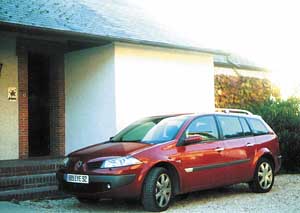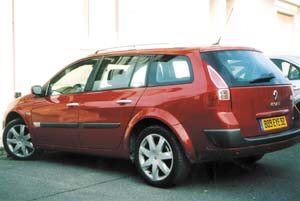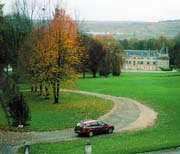|
living:
autocade
 The
grand European tour The
grand European tour


The Renault
Mégane Estate is not only good-looking, it trounces its opposition
convincingly, as Jack Yan
drives from Paris to Marne and back
photographed by the author
From issue 21 of
Lucire
THE FIRST TIME I laid eyes on the
second-generation Renault Mégane, I stared. Patrick Le Quément,
the design boss at Renault, had already been proven right in the
1990s with the Twingo, a car considered revolutionary in its day.
The team at Renault was on a roll, and Ford had shown the market
that unusual cars like the Focus could find favour with buyers.
The Mégane had to excite its sector.
Here was a vehicle with a bustle that France
hadn’t seen since Dior’s New Look. Europe gasped. But while the
rear end of the Mégane had its detractors, the car’s sales’
figures said otherwise—it put Renault into a strong position across
Europe, and even Golf-loving Germans began buying it.
But Renault knew there would be traditionalists
out there. People who expected their cars to be fluide. People
like me, who bought the first-generation Mégane, who might
judge the new model as stareworthy but not necessarily restrained.
Enter the Mégane Classic and Estate. The
Classic, the four-door, appeals to traditionalists who believe une
berline must have a proper boot. I am not one of them. However,
I did grow up in New Zealand, and the All Blacks were coming to
town here in Paris, so why not appeal to the Kiwi sensibility on
a nice, romantic holiday? The solution: a station wagon, or as the
model is called in France, the Estate.
Renault makes the Scénic, one of the most
successful mini-MPVs in the world.
But the Kiwi love for the wagon, whether it’s the horrid Daewoo
Lacetti (a.k.a. Holden Viva) or the Ford Falcon, never seems to
die. It’s in the blood. Chuck everything in the back and zoom off.
At least you won’t pollute the planet like the Ponsonby tractor
set.
Calling Jérôme Delgrange, Renault’s
very effective press contact, I was immediately asked: which model?
For how long? Answer: the Mégane 1·9 dCi Estate, with a new
130 hp diesel. Pour une sémaine, s’il vous plaît.
This was the grand French tour we had promised ourselves, venturing
from Paris, out to Marne—specifically Champagne—and down to
Nevers for the jazz festival. (We never made it to Nevers. French
plonk is too good.)
The six-speed manual impressed the first person
who drove it. Since I was flying in after hours, Stanley Moss, Lucire’s
travel correspondent, collected the car for me and was raving about
its GPS system. The system had an
encyclopædic knowledge of Paris, including sites of interest.
An additional CD-ROM
contained extra locations, if needed.
Other conveniences included keyless entry. A
credit card-shaped device, with the usual lock and unlock buttons,
could be stored in one’s front pocket—the back is not a good idea,
in case you sit on it—and as you got close to the car, you could
lock or unlock the doors. A button started the ignition. While hardly
new—Audi owners are yawning right now—bear in mind this is on a
mid-sized, good-value car, costing roughly €24,000 in this part
of the world.
Elsewhere, it was all about convenience: the
necessities for the grand European tour. Windscreen wipers were
automatic—again a nice touch on a well priced car, though in heavy
rain, you were better to switch them on properly. Lights were automatic
as well. Seats on the Mégane have always been great, especially
if you need to drive long distances. And it is filled with airbags
galore.
The two-part tailgate was handy, so you could
throw stuff in casually or open it up properly for the luggage.
We shopped madly at least once, and we still had room to spare.
If we had the hatch, we would have struggled to be as comfortable.
For with the Estate, a passenger can get out of her seat, go into
the back, get food, and return, as though the Mégane was
a small home. And a rather stylish one, too, free from the incongruity
of the hatch.
But we men need to find out other things: handling,
performance and ride. Despite being a wagon, the Mégane is
very responsive, and the ride was good enough for my companion to
sleep through one morning. We found we needed the ride height over
less than ideal roads out in the countryside—plus a particularly
tricky, stepped road.
However, what really put the Mégane into
Focus- and Golf-beating consideration is its performance. I’d say
this is the best in class. In Paris, this is needed in a hesitate-and-crash
mentality. I had feared a lack of power, as with my own Mégane.
Yet between 30 and 70 km/h, pick-up is astounding, especially considering
you are lugging a lot of metal behind you. It netted us mileage
of 5·9 litres per 100 km (41 mpg to me)—amazing, considering
how much we had in the back and that occasionally, the voice on
the GPS led us astray.
This was the ideal car to put bottle after bottle
of champagne with each house visited. Being a wagon, you look sensible.
No one would suspect you were stocking up on booze to bring back
to Aotearoa. Especially when you do it so stylishly. •
|

Renault knew there would be traditionalists out
there. People who expected their cars to be fluide. People
like me, who bought the first-generation Mégane, who might
judge the new model as stareworthy but not necessarily restrained
|

